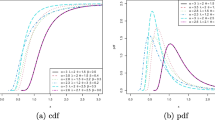Abstract
The Bayesian maximum entropy (BME) method can be used to predict the value of a spatial random field at an unsampled location given precise (hard) and imprecise (soft) data. It has mainly been used when the data are non-skewed. When the data are skewed, the method has been used by transforming the data (usually through the logarithmic transform) in order to remove the skew. The BME method is applied for the transformed variable, and the resulting posterior distribution transformed back to give a prediction of the primary variable. In this paper, we show how the implementation of the BME method that avoids the use of a transform, by including the logarithmic statistical moments in the general knowledge base, gives more appropriate results, as expected from the maximum entropy principle. We use a simple illustration to show this approach giving more intuitive results, and use simulations to compare the approaches in terms of the prediction errors. The simulations show that the BME method with the logarithmic moments in the general knowledge base reduces the errors, and we conclude that this approach is more suitable to incorporate soft data in a spatial analysis for lognormal data.




Similar content being viewed by others
References
Aitchison J, Brown JAC (1957) The lognormal distribution. Cambridge University Press, Cambridge
Christakos G (1990) A Bayesian/maximum-entropy view to the spatial estimation problem. Math Geol 22:763–777
Christakos G (2000) Modern spatiotemporal geostatistics. Oxford University Press, New York
Christakos G, Bogaert P, Serre ML (2002) Temporal GIS: advanced functions for field-based applications. Springer, New York
Cressie N (2006) Block kriging for lognormal processes. Math Geol 38:413–443
Deutsch CV, Journel AG (1998) GSLIB: geostatistical software library and user’s guide. Oxford University Press, New York
Douaik A, Van Meirvenne M, Tóth T (2005) Soil salinity mapping using spatio-temporal kriging and Bayesian maximum entropy with interval soft data. Geoderma 128:234–248
Dowd PA (1982) Lognormal kriging—the general case. Math Geol 14:475–499
Journel AG (1980) The lognormal approach to predicting local distributions of selective mining unit grades. Math Geol 12:285–303
Journel AG, Huijbregts ChJ (1978) Mining geostatistics. Academic Press, London
Kapur JN, Kesavan HK (1992) Entropy optimization principles with applications. Academic Press, London
Kendall MG, Stuart A (1963) The advanced theory of statistics, vol 1: distribution theory. 2nd edn. Charles Griffin & Company Limited, London
Kerry R, Oliver MA (2007) Determining the effect of asymmetric data on the variogram. I. Underlying asymmetry. Comput Geosci 33:1212–1232
Lee Y-H, Ellis JH (1997) Estimation and simulation of lognormal random fields. Comput Geosci 23:19–31
MATLAB (2004) MATLAB 7.0.1. The MathWorks Inc., Natick
Orton TG, Lark RM (2007a) Estimating the local mean for Bayesian maximum entropy by generalized least squares and maximum likelihood, and an application to the spatial analysis of a censored soil variable. Eur J Soil Sci 58:60–73
Orton TG, Lark RM (2007b) Accounting for the uncertainty in the local mean in spatial prediction by Bayesian Maximum Entropy. Stoch Env Res Risk A 21:773–784
Pawlowsky-Glahn V, Olea RA (2004) Geostatistical analysis of compositional data. Oxford University Press, New York
Rawlins BG, Lark RM, Webster R, O’Donnell KE (2006) The use of soil survey data to determine the magnitude and extent of historic metal deposition related to atmospheric smelter emissions across Humberside, UK. Environ Pollut 143:416–426
Rendu J-MM (1979) Normal and lognormal estimation. Math Geol 11:407–422
Rivoirard J (1990) A review of lognormal estimators for in situ reserves. Math Geol 22:213–221
Roth C (1998) Is lognormal kriging suitable for local estimation? Math Geol 30:999–1009
Savelieva E, Demyanov V, Kanevski M, Serre M, Christakos G (2005) BME-based uncertainty assessment of the Chernobyl fallout. Geoderma 128:312–324
Serre ML, Christakos G, Lee SJ (2004) Soft Data Space/Time Mapping of Coarse Particulate Matter Annual Arithmetic Average over the US. In: Sanchez-Vila X, Carrera J, Gomez-Hernandez J (eds) Proceedings of the 4th conference on geostatistics for environmental applications, geoEnV IV. Quantitative geology and geostatistics. Kluwer, Dordrecht
Wackernagel H (2003) Multivariate geostatistics: an introduction with applications. Springer, Berlin
Webster R, Oliver MA (2001) Geostatistics for environmental scientists. Wiley, Chichester
Acknowledgments
This research was funded by the Biotechnology and Biological Sciences Research Council of the United Kingdom through its Core Strategic Grant to Rothamsted Research. We are grateful to the comments of the reviewers, through which the paper has been greatly improved.
Author information
Authors and Affiliations
Corresponding author
Appendix A
Appendix A
In this appendix, we show that the multivariate lognormal distribution, Eq. (7), is the maximum entropy pdf for a vector of variables, \( {\mathbf{Z}} = {\left( {Z_{1} ,Z_{2} ,...,Z_{N} } \right)}^{{\text{T}}} , \) given the general knowledge base stated in Eq. 6.
For a transformation, Y = φ(Z), the pdfs for Z and for Y are linked by:
So the entropy for f(z) is given by:
where J is the Jacobian of the transformation. In the case of φ(Z) being the logarithmic transform we get \( J = {\prod {1 \mathord{\left/ {\vphantom {1 {z_{i} }}} \right. \kern-\nulldelimiterspace} {z_{i} }} }; \) the expectation on the right-hand side of Equation (A2) now gives the sum of the expectations of the y i s, which are known because of our constraints on the logarithmic means, \( {\int\limits_{ - \infty }^\infty {y_{i} g{\left( {\mathbf{y}} \right)}} }{\text{ d}}{\mathbf{y}} = \mu _{i} . \) Therefore we have:
Thus, if we choose g(y) such that it maximizes H Y[g(y)] over all distributions for Y, then we know that this distribution gives the maximum value of the entropy, H z[f(z)], over all distributions for Z. Since the Gaussian distribution for g(y) maximizes H Y[g(y)], the back-transform of this distribution through Equation (A1) (i.e. the multivariate lognormal distribution) is the maximum entropy pdf for the SRF, Z, given the mean and covariance for Y.
Rights and permissions
About this article
Cite this article
Orton, T.G., Lark, R.M. The Bayesian maximum entropy method for lognormal variables. Stoch Environ Res Risk Assess 23, 319–328 (2009). https://doi.org/10.1007/s00477-008-0217-7
Published:
Issue Date:
DOI: https://doi.org/10.1007/s00477-008-0217-7




